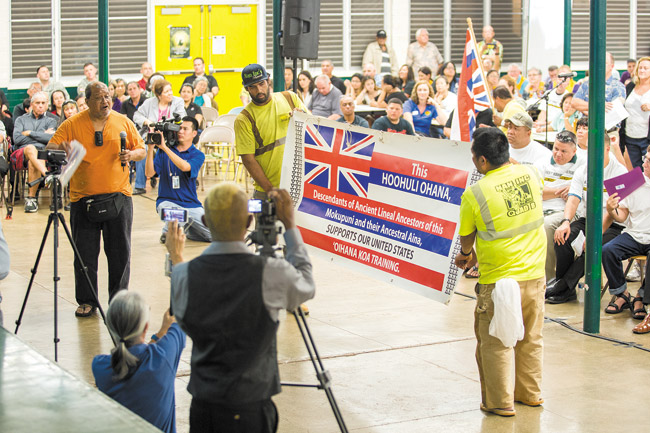State Rallies With Testimony Regarding Military, Civilian Jobs
After a slow start, Oahu business leaders and legislative representatives are moving quickly in an attempt to scuttle possible plans to reduce military and civilian employment at Fort Shafter and Schofield Barracks.
In June, the Army released an environmental assessment (EA) supplement to its 2020 Force Structure Realignment report. The cuts would affect more than 30,000 family members and cost the state $1.35 billion.
wo-020415-leilehua-meeting-ac-06
A petition by Chamber of Commerce of Hawaii and Keep Hawaii’s Heroes gathered more than 42,000 signatures against cutting civilian and military jobs in Hawaii.
Plans call for the reduction of active-duty soldiers from a high of 495,000 troops down to 440,000 or 450,000. Sequestration budget cuts could reduce the total number to 420,000 or lower, if the cuts are not reversed by 2016.
Gov. David Ige said the state’s isolation makes any cuts especially difficult. U.S. Sen. Mazie Hirono called the cuts irresponsible; U.S. Rep. Mark Takai chose the word tragic. U.S. Sen. Brian Schatz, U.S. Rep. Tulsi Gabbard and state Sen. Will Espero highlighted President Barack Obama’s focus on the Asia/Pacific region and possible military and economic threats from China and North Korea.
The environment assessment examined the impact of a possible loss of 19,786 military and civilian jobs, plus their estimated 30,035 family members, at the two bases. Final numbers may be lower, as the potential reduction numbers in the EA exceeds levels called for in the realignment report. However, the EA said force reduction could expand, should the sequestration-level cuts come into effect in 2016. Dan Wicker, director of Keep Hawaii’s Heroes (KHH), which aims to limit or stop any cuts in military and civilian employment, said the threat is real.
“Looking at the reports and talking to people who work in the congressional arena and the Army, they are faced with budget cuts,” said Wicker. “The sequestration was real and the Army has to make cuts.”
Those cuts, if taken to the maximum, could result in the loss of 26,776 associated jobs (4.3 percent of Oahu’s population), plus an annual reduction of $1.3 billion in spending and $9.2 million in sales tax receipts, according to the environmental assessment.
The EA looked at 14 areas of impact ranging from biological and cultural resources, to the economy and transportation. A loss of nearly 20,000 military and civilian employees on Oahu was determined to have a significant socioeconomic impact, while a reduction would benefit almost every other category. Find the full report at aec.army.mil/Portals/3/nepa/Army2020SPEA-FNSI.pdf.
To gather information and testimony about the impact of a possible troop reduction, the Army led two Listening Sessions: 6:30 p.m. Jan. 27 at Hale Koa Hotel and Jan. 28 at Leilehua High School.
“They want to see everything the Army touches — partnerships, economy, community projects, what they do with our schools,” said Wicker, who stressed the sessions are the last chance for the community to impact the Army’s decision.
Testimony from the two listening sessions will be presented to Army leaders in Washington. A decision on the cuts could come by mid-2015.
As of Jan. 26, Keep Hawaii’s Heroes has collected 37,252 petition signatures supporting current troop and civilian employment numbers. To date, the number of other supporting documents has lagged those for other bases recommended for cuts.
According to KHH, Fort Polk, La., generated 17,000 letters of support compared to just 30 for Oahu’s Army bases.
“It is our fault, as residents of Hawaii,” said Wicker, who noted the late U.S. Sen. Daniel Inouye’s impact on maintaining the state’s military funding.
“I think we got too comfortable and we depended on our congressional delegation to weigh in to minimize any significant repositioning here at our military installations.”






